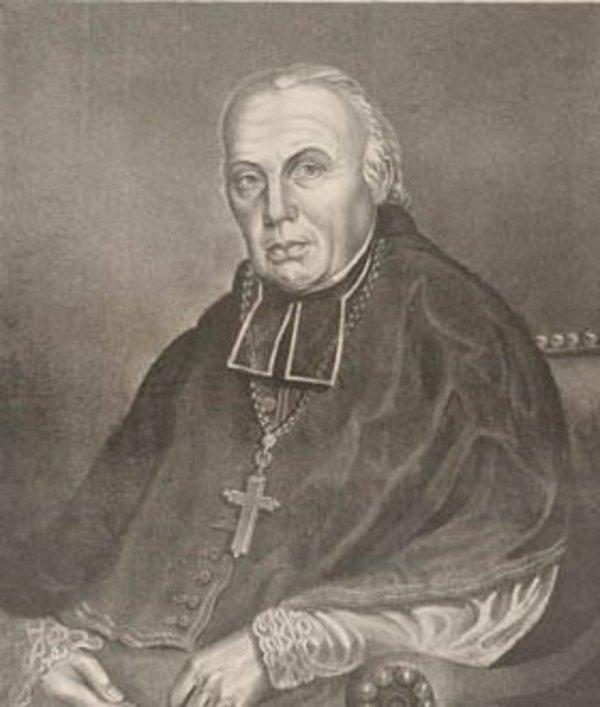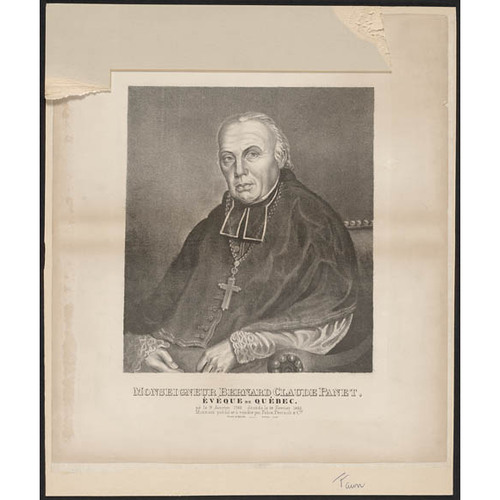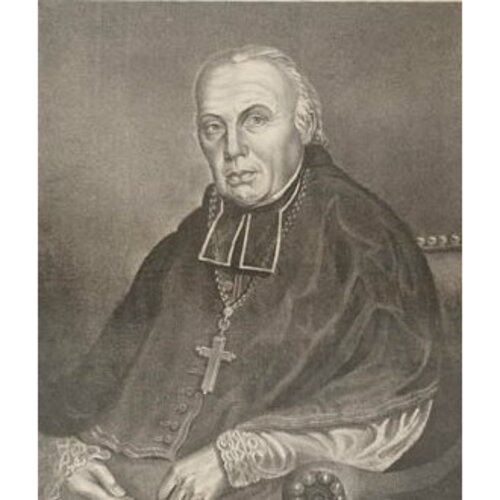
Source: Courtesy of Wikimedia Commons
PANET, BERNARD-CLAUDE, Roman Catholic priest and archbishop; b. 9 Jan. 1753 at Quebec, son of Jean-Claude Panet*, a notary, and Marie-Louise Barolet; d. there 14 Feb. 1833 at the Hôtel-Dieu and was buried four days later in the cathedral of Notre-Dame.
Bernard-Claude Panet came from a family of 14 children, among them Jean-Antoine*, who became the first speaker of the Lower Canadian House of Assembly, and Jacques, who was parish priest at L’Islet from 1779 to 1829. He received his entire education at the Petit Séminaire and the Grand Séminaire de Québec. Ordained priest by Bishop Jean-Olivier Briand* on 25 Oct. 1778, he taught the sixth form (Rhetoric) and the final two years of the classical program (Philosophy) at the Petit Séminaire from 1777 till 1780. One of his pupils was Joseph-Octave Plessis.
In the autumn of 1780 Panet was chosen to minister to the parishes of Batiscan and Champlain. The following year he became parish priest of Notre-Dame-de-Liesse, at Rivière-Ouelle, a progressive parish that was, however, being undermined by strife. The authority of its previous curé, Jean-Louis-Laurent Parent, had always been hotly disputed, particularly during the American invasion in 1775, and in 1780 some people had even called upon him to leave. Bishop Briand had not given in to the rebellious parishioners, but after Parent’s death in March 1781 he had to find a successor who could settle things down. Panet was “by nature kind and affable, pious, zealous, and charitable,” as his biographer Mgr Henri Têtu noted, and by displaying great patience and diplomacy he restored harmony. A practical and methodical man, he administered the parish in an exemplary manner. He also showed himself to be extremely charitable, feeding poor children who attended catechism and people who came from some distance to the church and had to wait around for vespers. He never refused to give alms, even to strangers.
In 1792 he secured general agreement from his parishioners to erect a new church; he was named treasurer and chief supervisor of the project. The building was completed in 1794, but for some years he continued working on its decoration, giving contracts to such craftsmen as Louis Dulongpré*, François Baillairgé, and Louis Quévillon. He uniformly bought consecrated vessels of great value. Being particularly interested in teaching, Panet had a convent built in 1807 and there, two years later, he installed the sisters of the Congregation of Notre-Dame. He had the fabrique establish an elementary school in 1824. He was also interested in agriculture and settlement and set an example by joining the Agriculture Society in the district of Quebec in 1791 and serving as a patron for the Société Auxiliaire d’Agriculture de Sainte-Anne de la Grande-Anse.
Panet’s influence soon spread beyond his parish. The bishop of Quebec chose him as his delegate in the region between Quebec and Rimouski, particularly for the delicate missions that inquiries about building a presbytery (at Kamouraska, for example) or a church (at Trois-Pistoles, among other places) often proved to be. His wisdom and sense of fairness were generally recognized. This reputation did not escape the notice of his superiors. Plessis, who had been named bishop of Quebec in 1806, asked to have Panet as his coadjutor because, as he noted in a letter to Rome, he was “the best qualified in terms of piety, talents, and reputation,” and “highly thought of by his flock, which he has constantly edified by his regular life and his conscientious attention to preaching and the duties of holy ministry.”
On 12 July 1806, with the approval of the authorities in Great Britain and Rome, Panet was chosen as bishop of Saldae in partibus infidelium and coadjutor to the bishop of Quebec. He was consecrated by Plessis on 19 August of the following year. Plessis proposed to establish Panet in the Séminaire de Saint-Sulpice in Montreal, but the superior, Jean-Henry-Auguste Roux, twice resisted this step, fearing that his authority would be overshadowed and his independence diminished. Panet was happy to remain the curé at Rivière-Ouelle, where besides ministering to a large parish with 1,400 communicants in 1804 and 2,000 in 1826 he assumed the duties associated with his new title. These tasks obliged him to be absent from his parish more often, and to participate on a regular basis in the rather brilliant social life of the colony at this period.
As coadjutor Panet continued to preside over various inquiries and to settle virtually all the parish problems in the region below Quebec, which he duly reported to his bishop in voluminous correspondence. His main task, however, was making pastoral visits to various areas, including the north shore of the St Lawrence. In the Montreal region from 1814 he was accompanied by the Sulpician Jean-Jacques Lartigue*.
During Plessis’s stay in Europe in 1819–20 Panet moved to Quebec and ran the archdiocese in accordance with the instructions left by his superior, who had been named archbishop in 1819. On all occasions the coadjutor had been Plessis’s chief counsellor. For example, when Plessis wanted to publish a new catechism, Panet encouraged him by acknowledging that “the shorter Quebec catechism could be greatly improved,” and sent some observations that he had conveyed to the parish priests in his district, and later some remarks on the text that Plessis had prepared; when a debate arose between Plessis and certain Sulpicians following publication of the new Petit catéchisme du diocèse de Québec in 1815, the coadjutor took the bishop’s side, even while criticizing some expressions and turns of phrase as faulty. This example illustrates well how Panet saw his role as coadjutor: a judicious counsellor for his superior, whom he supported while retaining the right to his own ideas.
When Plessis died in December 1825, the 72-year-old Panet became archbishop of Quebec. There was apprehension in certain quarters, particularly in Montreal, about what attitude the new incumbent would take. Would this “quiet man” with the conciliatory spirit not let himself be outwitted by the skilful manœuvring of the government or the subtle arguments of the Sulpicians? He quickly made known, however, his desire to follow in the footsteps of his predecessor and to leave things as he had found them, “without changing anything in any way.” The Sulpicians were the first to discover that these were not idle words. In December 1825 their superior, Roux, who had come to put out feelers and suggest certain arrangements, met with the reply from the new archbishop that he would adopt the same position as Plessis had held. When Lartigue, who had become the auxiliary in Montreal to the archbishop of Quebec on 21 Jan. 1821, encountered difficulties with his former colleagues in the Séminaire de Saint-Sulpice, Panet fully backed him and unhesitatingly censured the Sulpicians’ conduct severely. Similarly, when the Sulpicians proposed to the British government that part of their property be exchanged for an income in perpetuity [see Jean-Henry-Auguste Roux], Panet joined Lartigue in denouncing this “despoliation of the Canadian church’s property,” and together they eventually succeeded in getting Rome and London to reject the agreement that the Sulpicians obtained in 1827. In March 1830 Rome temporarily suspended the permission previously granted to Roux to alienate the seminary’s property, and in October the British government decided against carrying out the arrangements that had been made with the Sulpicians. Finally, while restraining his impetuous auxiliary somewhat, Panet supported him steadfastly in his efforts to create a diocese in Montreal. He showed the same firmness in dealing with the rest of his clergy. To ensure respect for some of his decisions, in particular changes in parish charges, he did not hesitate to be stern, even though his naturally kind character made him lean to indulgence. He was sometimes accused of being autocratic, but there is every indication that he was able to gather around him a council of wise men whom he consulted on all important questions.
Panet’s relations with the governmental authorities were marked with prudence and apprehension. Unlike Bishop Lartigue, who preached independence with regard to the state, Panet did not dare to undertake anything without the government’s approval, and he often put off actions that could cause a conflict with the Executive Council. To justify this course, he always referred to the attitude that Plessis had adopted.
Education for the young was one of Panet’s main concerns during his term. He supported the Collège de Sainte-Anne-de-la-Pocatière and especially the Séminaire de Nicolet with both his influence and his money. For a time he hoped for the establishment of a Roman Catholic committee of the Royal Institution for the Advancement of Learning, but in its absence he was instrumental in obtaining grants through an act of 1829 to build schools and support various colleges, academies, and convents in Lower Canada. In 1829 he also completed his predecessor’s work on the catechism, publishing the Grand catéchisme à l’usage du diocèse de Québec.
Several other matters took up Panet’s attention: a bill expanding the role of the fabriques [see Louis Bourdages], which through his efforts was blocked by the Legislative Council; the problem of the civil erection of parishes, which was finally settled in 1831; the cholera epidemic which struck Quebec and Montreal in 1832. These concerns and his advanced age impelled him to offer his resignation in order that his powers might pass to his coadjutor, Bishop Joseph Signay*. Rome refused it twice, in the autumn of 1831 and in January 1832, although allowing him to delegate some of his authority. But as his strength was declining rapidly, Panet entrusted administration of the archdiocese to Signay on 13 Oct. 1832 and retired to the Hôtel-Dieu in Quebec the following month. There, on 14 Feb. 1833, he died, leaving behind the memory, as Signay said, of “tender piety, unfailing gentleness, compassionate charity towards others, constant zeal for the salvation of his flock.” Mgr Têtu emphasized that “his modest talents, his rare good sense” had been sufficient to ensure that he would not be eclipsed by his illustrious predecessor.
AAQ, 20 A, IV; 210 A, VIII–XIV; 24 CP, I–IV. ANQ-Q, CE1-1, 10 janv. 1753, 18 févr. 1833. Arch. du séminaire de Nicolet (Nicolet, Qué.), Séminaire, I: 21. ASQ, Polygraphie, XIV: 7A. [J.-O. Plessis], Le petit catéchisme du diocèse de Québec, approuvé et autorisé (Québec, 1815). “Testament de Mgr Panet, évêque de Québec,” BRH, 51 (1945): 203–5. Allaire, Dictionnaire. Caron, “Inv. de la corr. de Mgr Panet,” ANQ Rapport, 1933–34; 1934–35; 1935–36. Henri Têtu, Notices biographiques; les évêques de Québec (Québec, 1889; réimpr. en 4v., Québec et Tours, France, 1930). Raymond Brodeur, “Identité culturelle et identité religieuse, étude d’un cas: Le pent catéchisme du diocèse de Québec, approuvé et autorisé par Mgr J. O. Plessis, Québec, le 1er avril 1815” (2v., thèse de phd, univ. de Paris-Sorbonne, 1982). Chaussé, Jean-Jacques Lartigue. P.-H. Hudon, Rivière-Ouelle de la Bouteillerie; 3 siècles de vie (Ottawa, 1972). Lambert, “Joseph-Octave Plessis.” Lemieux, L’établissement de la première prov. eccl. [M.-E. Perreault] Mme E. Croff, Nos ancêtres à l’œuvre à la Rivière-Ouelle (Montréal, 1931). Ivanhoë Caron, “La mort de Mgr Panet racontée par Mgr Signay,” BRH, 44 (1938): 7–8.
Cite This Article
Nive Voisine, “PANET, BERNARD-CLAUDE,” in Dictionary of Canadian Biography, vol. 6, University of Toronto/Université Laval, 2003–, accessed January 10, 2026, https://www.biographi.ca/en/bio/panet_bernard_claude_6E.html.
The citation above shows the format for footnotes and endnotes according to the Chicago manual of style (16th edition). Information to be used in other citation formats:
| Permalink: | https://www.biographi.ca/en/bio/panet_bernard_claude_6E.html |
| Author of Article: | Nive Voisine |
| Title of Article: | PANET, BERNARD-CLAUDE |
| Publication Name: | Dictionary of Canadian Biography, vol. 6 |
| Publisher: | University of Toronto/Université Laval |
| Year of publication: | 1987 |
| Year of revision: | 1987 |
| Access Date: | January 10, 2026 |




